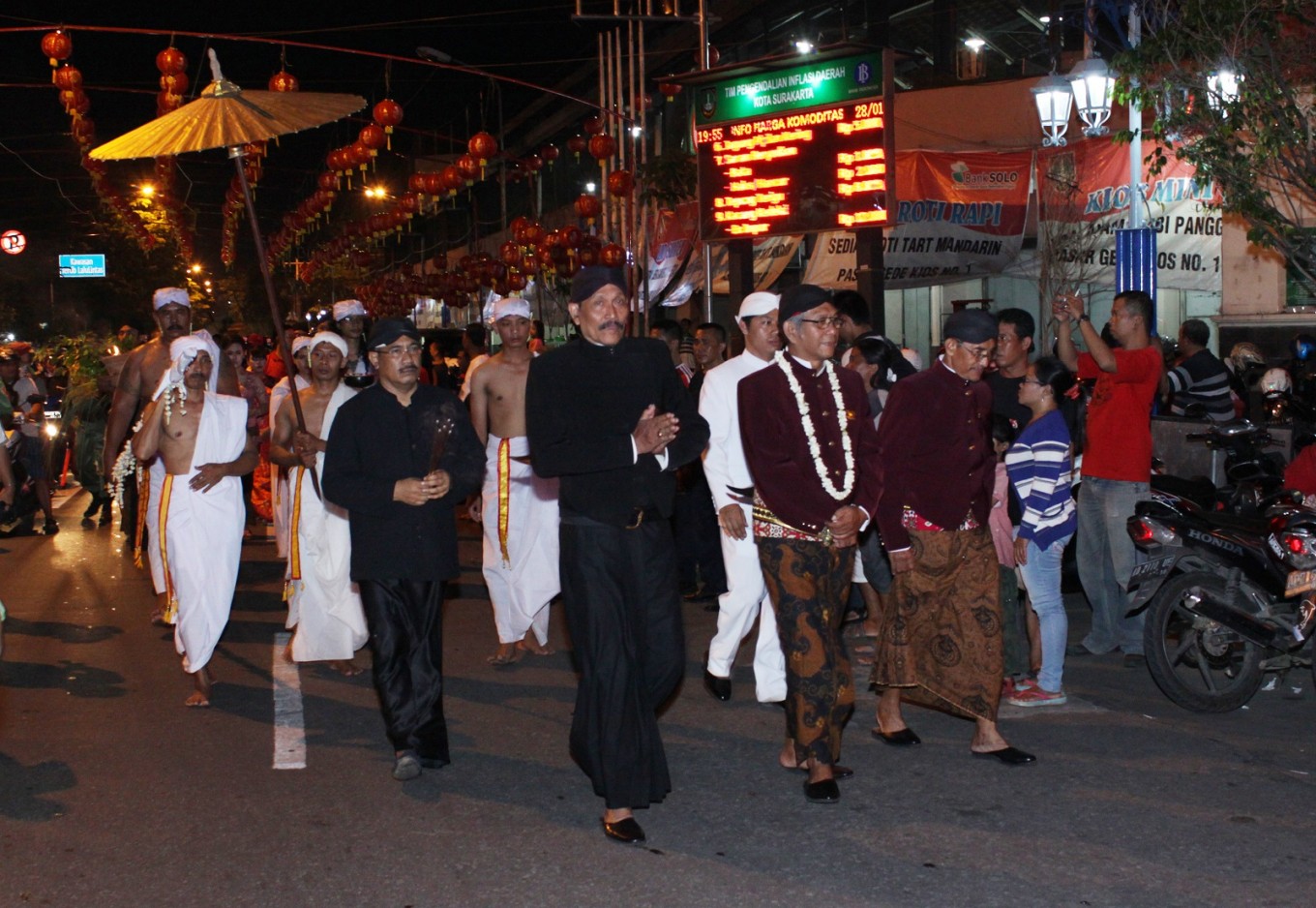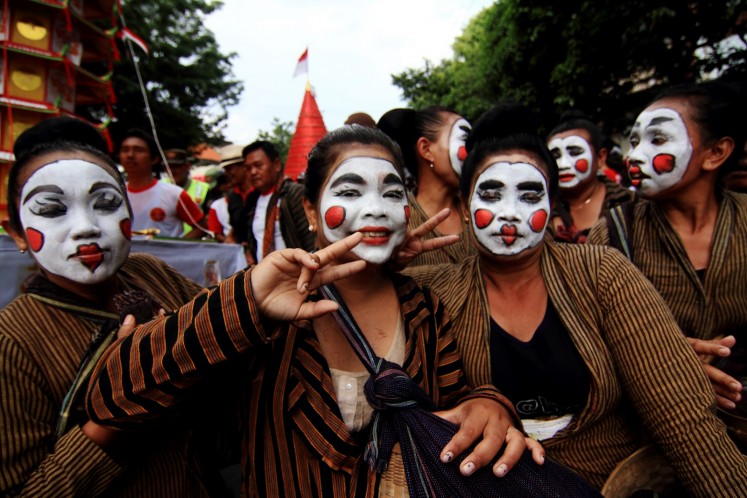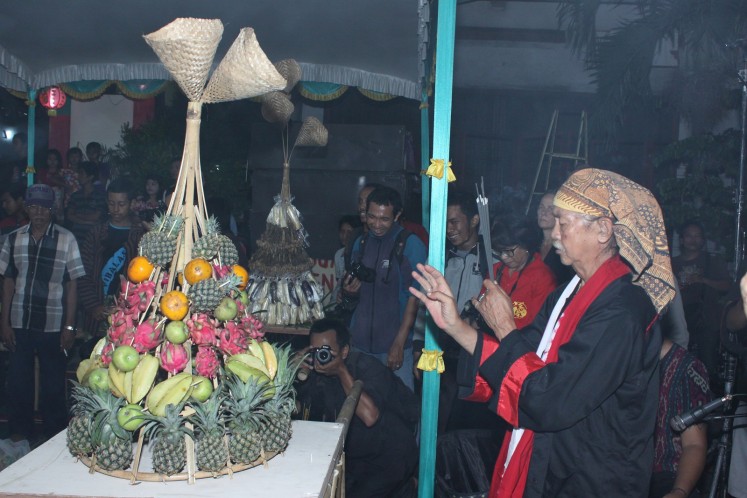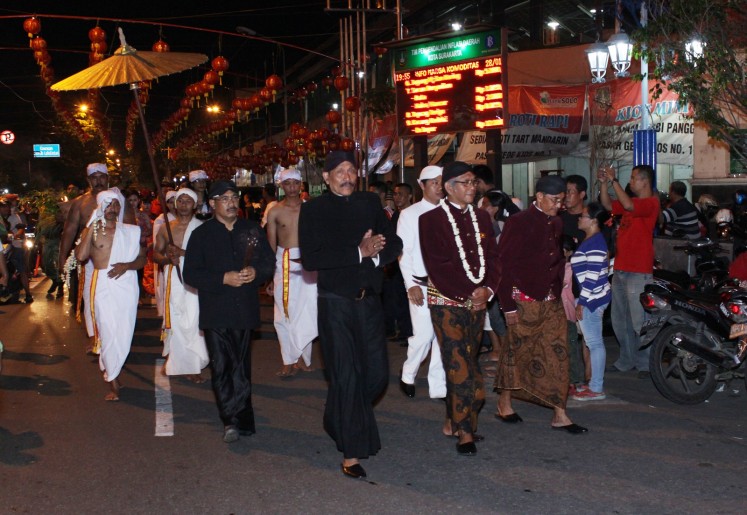Popular Reads
Top Results
Can't find what you're looking for?
View all search resultsPopular Reads
Top Results
Can't find what you're looking for?
View all search resultsEthnic harmony in Surakarta Chinatown
Sudiroprajan village in Surakarta represents the harmony of two cultures living side by side, as seen in the annual Grebeg Sudiro celebration.
Change text size
Gift Premium Articles
to Anyone
S
udiroprajan village in Jebres regency is a place where we can still find traces of Chinatown in Surakarta, Central Java. The distinct curved buildings of Chinese architecture are easy to spot in villages like Balong, Ketandan, Kepanjen, Mijen, Limolasan and Sudiroprajan.
Chinese descendants live in those villages, in small houses packed in narrow alleys alongside people of Javanese ethnicity. The hustle and bustle of a typical Chinatown is also apparent in Sudiroprajan. Houses serve as places of business, such as bakeries, beauty salons or tailor shops.
Chinese traces are also aplenty in the culinary world, found in meat buns, noodles, cakwe (fried dough) or kue keranjang (glutinous rice cakes). Kepanjen village is often called by its other name, kampung tenongan, where tenongan refers to the Javanese-Chinese cake sellers with their round baskets.
According to historian Heri Priyatmoko, ethnic Chinese have lived in Surakarta for around 274 years. Located in Sudiraprajan since the beginning, they lived harmoniously with the community as well as with those of Arabian descent in the Pasar Kliwon area.
Javanese people of Sudiroprajan with shadow puppet character costumes join the carnival welcoming the Chinese New Year. (JP/Ganug Nugroho Adi)In the 18th century, Surakarta king Paku Buwono X located the immigrants in Balong village behind Pasar Gede to vitalize the people’s trade in the area.
“Assimilation of ethnicity, culture and even beliefs among the Chinese and Javanese in Balong occurred in the beginning of the 1900s. It happened naturally,” said Heri.
This in turn became a sort of course for other Chinatown areas in Sudiroprajan, such as Kepanjen, Kentandan, Limolasan and Mijen.
Read also: Celebrating diversity through ‘Grebeg Sudiro’
Artist Suprapto Suryodarmo leads the "Umbul Mantram" ritual at Sudiroprajan village, Surakarta, Central Java. (JP/Ganug Nugroho Adi)At Sudiroprajan, assimilation and tolerance of religion and culture among the Javanese and Chinese has been something that took place organically. Both ethnicities have lived side by side, many marrying across cultures and having children.
“In Balong, Mijen, Limolasan and Kepanjen, most of the people went through kawin ampyang [ampyang marriage]. It has been around for quite some time,” said Sudiroprajan village head Dalimo.
Kawin ampyang refers to ampyang, a snack made from sugar and peanuts, according to a Chinese figure in Surakarta, Henry Susanto. Sugar is seen as a symbol of Java, while peanuts represent the Chinese.
“Ampyang tastes sweet, just like diversity. Differences are beautiful when we regard them properly,” said Henry.
The multicultural ties in these Chinatowns have stood the test of time. There were 15 race-related conflicts among the Javanese and Chinese in Surakarta, while two of the largest happened in 1980 and 1998.
At that time, almost all of the youngsters in Sudiroprajan, both Javanese and Chinese, guarded the roads toward Sudiroprajan from riots. None were provoked by the conflict.
People of Sudiroprajan village in Surakarta, Central Java, held the "Umbul Mantram" ritual, or recitation of prayers for welcoming the Chinese New Year. People of Javanese and Chinese descents hold the event annually. (JP/Ganug Nugroho Adi)In Balong village, it is normal to hear the sound of someone reciting Islamic prayers while smoke from incense hovers from a neighboring house.
“Even within one family, we hold different religions. We’re able to be together because we respect one another. Staying away from extremist ways means staying away from religious clashes,” said Surip Slamet Rahayu, 49, a Javanese woman married to Oei Bing Kie, 59, a Chinese man.
Surip, who is a Christian, finds no problem with her husband praying in the temple. When it is her turn to go to the church, her husband or their Muslim children take her there.
Read also: A mash of Chinese New Year, cultural diversity in Surakarta
This kind of harmony is apparent in Grebeg Sudiro, an annual celebration to welcome the Chinese New Year, held since 2007. Mixing Javanese and Chinese influences, people bring mounds of produce and cakes from the two cultures, as well as art performances.
“This annual carnival has become a part of Surakarta. Grebeg Sudiro is an icon to remind us to live peacefully in diversity and differences,” said Surakarta Mayor FX Hadi Rudyatmo. (wen)














